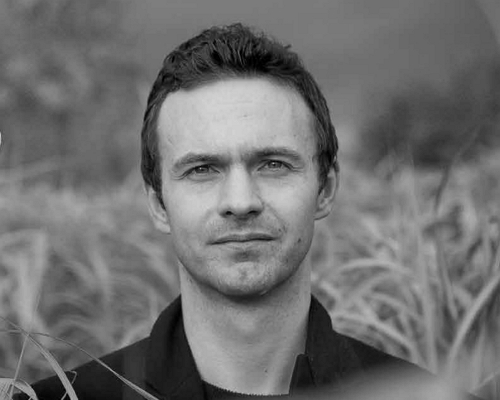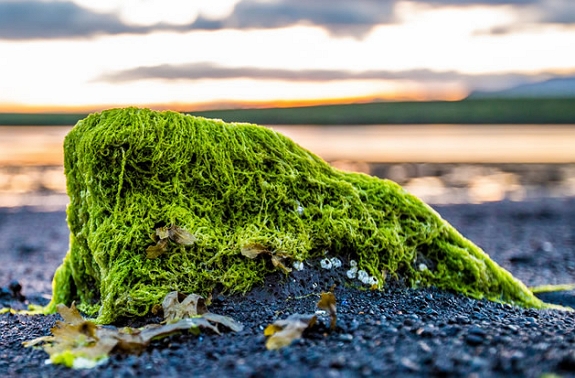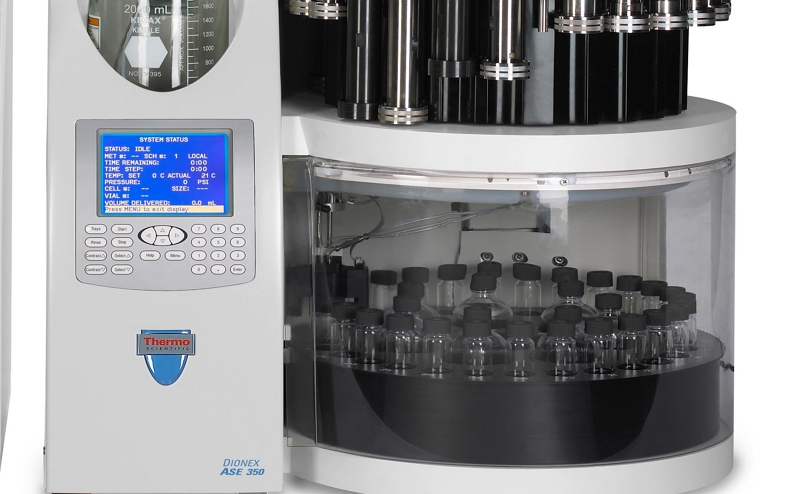Processes for the Extraction of Bioactives from Red Seaweed
Background
Many bioactives and other high-value plant constituents can be considered to be a part of the biomass extractives, which are defined as extraneous components that may be separated from the insoluble cell wall material by their solubility in water or neutral organic solvents.
Click here to learn more about the ways in which bioprocesses can be developed to efficiently and sustainably extract these extractives from biomass, with particular selectivity towards the bioactives and chemicals of interest.
Get more info...Extraction Processes
Bioactives in Red Seaweed
Red seaweeds are characterized by their distinctive red or purplish color, which comes from phycobiliproteins (a red protein-pigment complex), with phycoerythrin being the most common phycobiliprotein found in red algae. Phycobiliproteins absorb blue light, which penetrates water deeper than light of longer wavelengths, allowing red seaweeds to inhabit greater depths than other types of seaweeds.
In addition to phycobiliproteins, red seaweeds also contains other pigments such as chlorphylls and carotenoids.
Red algae also contain proteins, phenolic compounds, sterols, flavonoids, and a variety of vitamins and minerals. The composition of these compounds can vary depending on the species, as well as environmental conditions and the growth stage of the seaweed.
In red algae, eicosapentanoic acid (EPA) and docosahexaenoic acid (DHA) are the N-3 PUFAs of particular interest.
For example, red seaweeds, such as species of the Laurencia family, are known to produce a variety of brominated compounds, including brominated indoles, phenols, and terpenes. Some of these have been found to have antimicrobial and antifouling properties, which can help protect the seaweed from bacterial infection and overgrowth by other organisms. These halogenated compounds in seaweeds can exhibit various bioactivities, including antibacterial, antiviral, antifungal, antiprotozoal, and antitumor activities, making them of interest for potential pharmaceutical applications.
For example, many bioactive components (such as polyphenols (including bromophenols and flavonoids), vitamins, hormones, pigments, and minerals) can be extracted in the aqueous extract for subsequent plant, animal, and human uses. Then, the polysaccharides from the residue can be extracted, fractionated, and purified for medical, cosmetic and food applications.
The team at Celignis are experts in both the chemistry and processing of seaweed and can work with you on the development of an optimised extraction process for your feedstock.
Further Info on Classes of Bioactives in Red Seaweed
Examples of some phycobiliproteins found in red seaweed are listed below:
- Phycoerythrin -This is the most common phycobiliprotein found in red algae. One red seaweed species that contains phycoerythrin is Porphyra (also known as Nori, widely used in sushi), specifically the type called Porphyra umbilicalis.
- Phycoerythrin Subtypes - There are also subtypes of phycoerythrin, referred to with either R, C, or B prefixes, present in some red seaweeds. For example: Gracilaria tikvahiae contains R-phycoerythrin, Ceramium rubrum contains C-Phycoerythrin, and Porphyridium cruentum contains B-phycoerythrin.
- Phycocyanin - Its presence is usually associated with bluish colour in algae. An example of a red seaweed species that contains phycocyanin is Antithamnionella spirographidis.
- Phycocyanin Subtype - C-phycocyanin can be found in red algae like Antithamnionella spirographidis.
- Allophycocyanin - This phycobiliprotein is generally less abundant in red seaweed than phycoerythrin. Species of Gracilaria, a red seaweed widely used for agar production, contain allophycocyanin.
Get more info...Phycobiliproteins
Examples of some carotenoids found in red seaweed are listed below:
- Zeaxanthin - This carotenoid is also common in red seaweeds. For instance, the red seaweed Chondrus crispus, commonly known as Irish moss, contains zeaxanthin.
- Lutein - This carotenoid is less common in red algae compared to other types of seaweed, however an example of a red seaweed that does contain lutein is Porphyra species (known as Nori).
- Bet-Carotene - This carotenoid is widely distributed in many organisms and is present in a number of red seaweed species, for instance Palmaria palmata (known as dulse).
- Siphonaxanthin - This is a unique xanthophyll found in green seaweeds (Chlorophyta) and some red seaweeds.
- Siphonein - This carotenoid is specifically found in siphonous green algae, like Bryopsis, and some red seaweeds.
Get more info...Carotenoids
Examples of some sterols found in red seaweed are listed below:
- Cholesterol - Palmaria palmata, commonly known as dulse, has been reported to contain cholesterol.
- Fucosterol - An example of a red alga containing fucosterol would be species from the genus Gracilaria.
- Ergosterol - Species of the genus Laurencia have been found to contain ergosterol.
Get more info...Sterols
Analysis of Bioactives in Red Seaweed
Feel free to click on the links above to see more information on our methods of analysis for the different classes of bioactives or get in touch with us to request further information and a quotation.
Request a QuoteBioactives Analysis
Bioactives According to Other Seaweed Types
Get more info...Brown Seaweed
Get more info...Green Seaweed
Identification of High-Value Chemicals
For identification, we firstly get a crude extract from the feedstock, obtained via various approaches, including pressurised liquid extraction. This extract is then profiled using our top-range QTOF-LC/MS system (Agilent iFunnel 6550), which can identify constituents to the femtogram-level, and the spectra and chromatograms reviewed by Sajna, our Bioanalysis Developer. If necessary, we can collect the relevant fractions from the LC system and confirm the identification using a number of different chemical and spectroscopic techniques. We then determine which constituents warrant extraction.Develop an Optimised Extraction Protocol
Based on the identified chemical(s) of interest, we can then work on optimising a targeted extraction method. This method considers not only the yield of the target compound(s) but also the chemical and energy costs of the process and the implications for the downstream processing and valorisation of the solid residue. We consider a range of different extraction technologies, solvents, and process conditions.Typically, we first optimise the extraction at lab-scale conditions and then validate the chosen set of conditions at an nehanced scale (i.e. a higher technology readiness level (TRL)).
Separation and Purification of Target Chemical(s)
We can work on a process for the separation and purification of the targeted high value extractive compounds, while considering commercial viability and environmental aspects such as solvent and energy consumption. Based on the particular bioactive compound of interest and the composition of the liquid extract, we can employ a variety of different techniques for separation and purification.Application Testing of Extract or Separated Components
We can test the extract, or the separated compounds of interest, for a variety of different applications. The tests are custom-designed based on the extracted compound. For low molecular weight biomolecules (non food and feed), bioactivity tests, anti-microbial tests, UV absorbance properties, surface activities, and emulsion forming abilities can be tested. For the food and feed related extract fractions, such as proteins and carbohydrate polymers, nutritional properties, anti-nutritional compounds, emulsification, gelation, foaming (together with bioactive properties, in vitro digestibility etc.) are tested.Technoeconomic Analysis of the Process
The Celignis team, including Oscar our chief TEA expert, can undertake a detailed technoeconomic analysis of the developed process. We apply accurate and realistic costing models to determine the CAPEX and OPEX of simulated and pilot scale processes which are then used to determine key economic indicators such as IRR, NPV and payback periods.Our sensitivity analyses can assess the effect of variable costs and revenues, a particularly important aspect to consider given that the sale prices for some bioactive compounds can vary significantly according to their purity and market conditions.
Our preferred approach is to include TEA studies at each stage of the development of the extraction bioprocess, so that the process can be optimised in a commercially-relevant way, followed by a more detailed TEA after the process has been optimised and tested at higher TRL levels.
Click here to read more about the technoeconomic analysis (TEA) services offered by Celignis.
Bioprocess Biomass Extraction Projects - Case Studies
Betulin - UNRAVEL Project
Celignis worked extensively on biomass extraction and the purification of bioactive chemicals in the CBE/BBI project UNRAVEL where the extractives of 25 feedstocks were profiled using our QTOF-LC/MS system. We identified betulin in birch bark as the most attractive compound and subsequently worked on developing an optimised extraction protocol and an isolation/purification process scheme that offered several advantages, in terms of sustainability and safety, over the current art. Click here for a news article on this work.SteamBioAfrica Project
We are also using employing our compositional analysis and purification expertise in the Horizon Europe project SteamBioAfrica where we evaluate and process the liquid condensate obtained from the steam torrefaction process and consider market applications for its constituents, fractions, and derivatives.Celignis is testing the separation of acids, phenolics, and aldehydes for their potential to be used as high value bioactive compounds and biopesticides.
Bioactives Profiling of Tropical Trees
Celignis undertook detailed analysis of a wide variety of tropical hardwood trees for a client. This involved characterisation of different anatomical fractions (e.g. stem wood, bark, foliage). There was a particular focus on the composition of the extractives of these feedstocks. We used our QTOF-LC/MS system to profile the diverse and complex array of bioactive compounds present in the samples. We then evaluated the identified compounds and selected key chemicals that could be of high potential value for sale in different markets. We then undertook a review of these compounds, considering their potential value in various markets, the processes that could be required for their separation and purification, and whether other compounds could also be obtained as part of the extraction/separation process. The final output of the project was a list of top feedstocks and chemicals for future bioprocess development.
With regards to the extraction of bioactives from biomass, the Celignis Bioprocess team members with the most experience in undertaking such projects are listed below. Feel free to contact them to discuss potential projects.

Lalitha Gottumukkala
Founder of Celignis Bioprocess, CIO of Celignis
PhD
<p style="text-align: left;">Has a deep understanding of all biological and chemical aspects of bioproceses. Has developed Celignis into a renowned provider of bioprocess development services to a global network of clients.</p>

Dan Hayes
Celignis CEO And Founder
PhD (Analytical Chemistry)
<p style="text-align: left;">Dreamer and achiever. Took Celignis from a concept in a research project to being the bioeconomy's premier provider of analytical and bioprocessing expertise.</p>

Sajna KV
Bioanalysis Head
PhD
<p style="text-align: left;">Our Biomass Detective! Designs, tests, optimizes and validates robust analytical methods for our bioprocess development projects. Such bespoke analysis is key to developing an optimised bioprocess.</p>


















